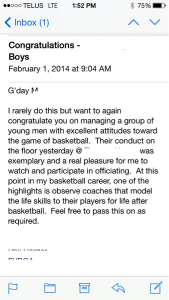Teaching Through Sport
I believe becoming a successful student-athlete, academically and athletically, is one of the most demanding tasks for teens and young adults. I also believe that being a student-athlete requires plenty of self-regulatory skills, explicit or inexplicit strategies. Student-athletes must balance a busy schedule and continually improve their craft in their respective sport if they intend to compete year after year. This connection between self-regulation and sport is important to myself because I believe my successful transition into post-secondary school was the result of my student-athletic background and extracurricular involvement. Furthermore, I’ve often understood teaching and coaching to be very similar. However, research and personal experiences have shown that the classroom is a not a team, but a community.
Basketball
Entering the season, the coaching staff aimed to implement several strategies to improve SRL among the players on the team: skills workout regimes for development outside of regular practice hours, goal setting exercises, team bonding activities, and player contracts. A strategy that I wish to discuss because of my experiences is the impact of player contracts. Player contracts were co-written with the players and the coaching staff, outlining player conduct on and off the court. Unfortunately, by midseason, a player had several misconducts requiring expulsion from the team. The process of relinquishing a player from a team was an extremely insightful experience and exemplified the importance of parental support. At the exit meeting, the entire coaching staff was present with a parental guardian and the student-athlete. After discussing the altercations, the student’s plans for restitution, and plans moving forward, it was reassuring to receive support and understanding from the guardian. The parent reaffirmed the student-athletes misconduct and remained in a calm demeanour throughout the meeting; demonstrating to the student-athlete the importance of accountability. Alternatively, player contracts proved successful in holding our student-athletes to high standards of sportsmanship.
(Figure 1) An email my coaching staff received regarding the conduct of our team on the court.
Our coaching staff received this email during a tournament weekend. It was following a game where our team had beaten another team quite convincingly, as it was expected. Nonetheless, our players played with class. It was a great confirmation and assurance that our team performed and competed in a manner that reflected the school community positively.
Baseball


